At first glance, squid and octopus might appear to be similar animals. But once you dive deeper, you’ll find some prominent distinctions. One notable feature that sets them apart is their shape. The bodies of squid and octopus are more elongated and rounded, respectively. A squid has two tentacles with eight arms, while an octopus only has eight arms. Size is another way these creatures differ, with squids being larger than octopuses.
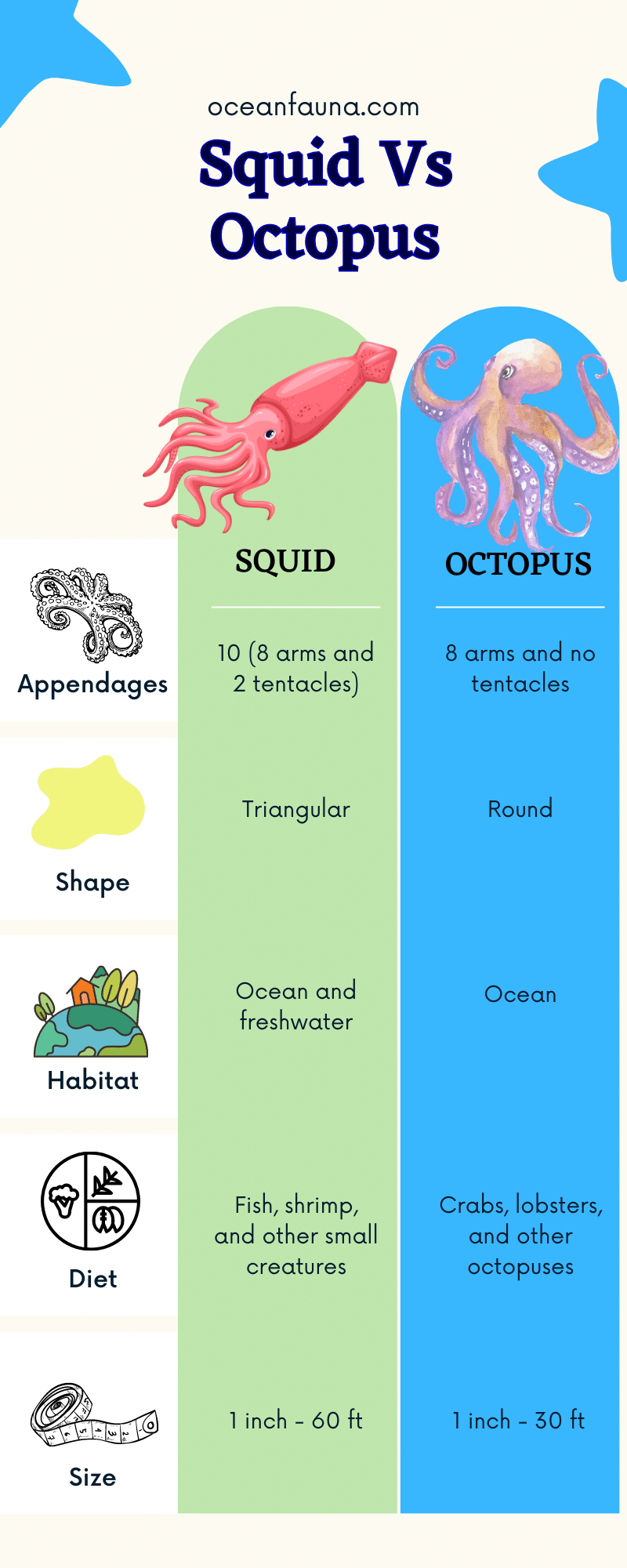
The Giant Squid, for instance, is the largest invertebrate in the world and can grow up to 60 feet long. In comparison, the Giant Pacific Octopus typically reaches lengths of around 30 feet.
But wait, there’s more than meets the eye! Octopuses outshine squids in the brain department. They can solve complex problems and use tools. They are more solitary than squids, which can form groups.
So even though squid and octopuses are both cephalopods, they’re different from each other.
Join us as we explore the intriguing world of squid and octopuses. We’ll discover all the ways they differ. Trust us – there is a whole ocean of differences to dive into!
Squid Vs Octopus – A Quick Comparison
Let’s first take a quick look at the differences between squid and octopus.
| Feature | Squid | Octopus |
| No. of appendages | 10 (8 arms and 2 tentacles) | 8 arms and no tentacles |
| Shape | Triangular | Round |
| Habitat | Ocean and freshwater | Ocean |
| Diet | Fish, shrimp, and other small creatures | Crabs, lobsters, and other octopuses |
| Behavior | Fast swimmer, found in schools | Not as fast swimmer, intelligent, solitary |
| Size | 1 inch – 60 ft | 1 inch – 30 ft |
| Weight | Less than 1 g to 1 ton | 1 g to 600 pounds |
| Lifespan | 1 – 5 years | 1 – 3 years |
Squid Vs Octopus – What Are the Key Differences?
Squids and octopuses are both cephalopods. They share some common traits, such as having soft, flexible bodies with multiple arms.
They are appreciated for their exceptional intelligence in adapting to different environments. They are like the chameleons of the sea, capable of altering their color to blend in perfectly with their surroundings.
But hold on tight. We’re about to untangle the confusion and highlight the major distinctions between these incredible creatures. Get ready for a guided tour of the undersea zoo!
1. Taxonomy and Classification
Squid and octopus belong to the same class of mollusks, the Cephalopoda, but they have different orders.
Squid
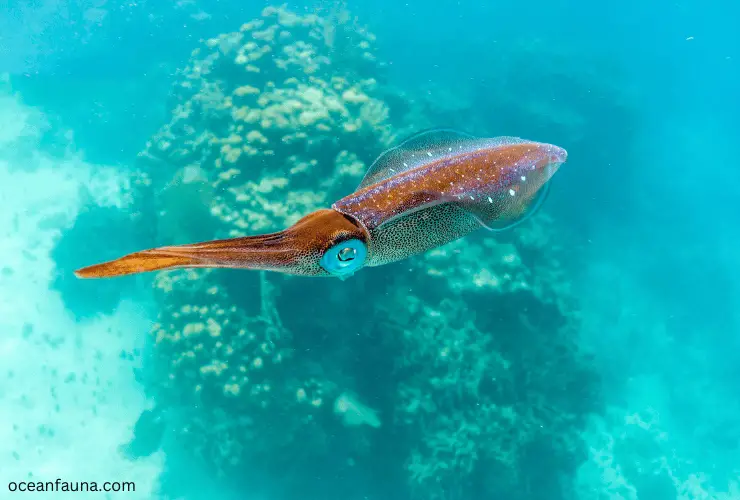
The Teuthida order, which has about 300 species, includes squid. It has two suborders:
- Myopsida (covered-eye squids)
- Oegopsida (open-eyed squids).
Octopus
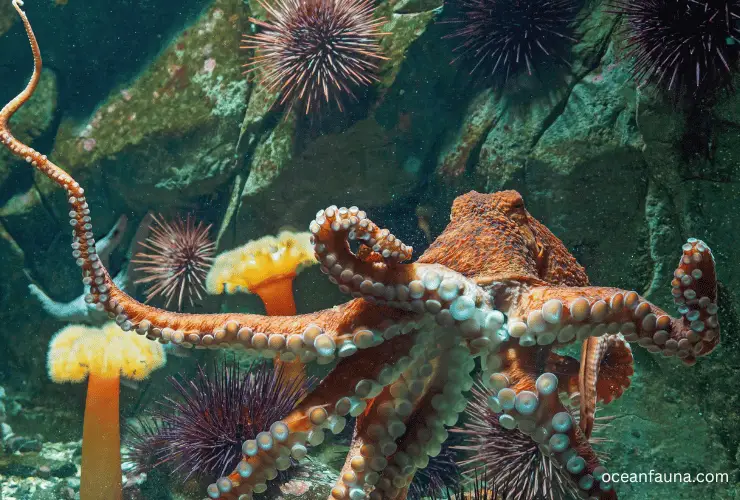
Octopus belongs to the order Octopoda, which also includes about 300 species. It has two suborders:
- Cirrata (finned octopuses)
- Incirrata (common octopuses).
| Classification | Squid | Octopus |
| Kingdom | Animalia | Animalia |
| Phylum | Mollusca | Mollusca |
| Class | Cephalopoda | Cephalopoda |
| Order | Teuthida | Octopoda |
| Suborders | Myopsida, Oegopsida | Cirrata, Incirrata |
2. Habitat and Distribution
Squids and octopuses have some habitat differences.
Squid
Squids live in all the world’s oceans, from the surface to the deep sea. They like to hang out freely in the big, open ocean. They can also migrate vertically, moving up and down the water column. You will most likely run into them in warm and cozy tropical waters. However, some species also swim in the cold depths of the ocean.
Octopus
Octopuses inhabit all of the world’s oceans and can be found along all the coasts of the United States. They are most common in warm, shallow waters. They can live in a variety of habitats, including coral reefs, rocky shores, and the seabed.
Octopuses are benthic, which means they live on the seabed. But they can also move across the bottom using their arms or jet propulsion.
| Characteristic | Squid | Octopus |
| Habitat | Open ocean | Seafloor |
| Distribution | Live in oceans, from the surface to the deep sea | All oceans, including the coasts of the U.S |
| Temperature preference | Warm and cozy tropical waters, but some species also swim in the cold depths of the ocean | Warm, shallow waters |
3. Physical Appearance
Squids and octopuses have different physical features that reflect their adaptations to their environment and lifestyle.
Squid
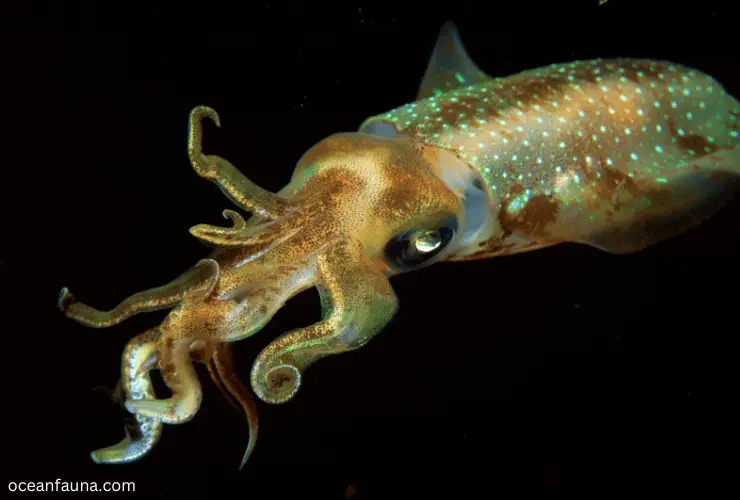
Squids have a streamlined body shape with triangular heads. They have a pair of fins on their mantle that help them steer and balance.
They have ten tentacles: eight shorter arms with suckers along their length and two longer tentacles with suckers only at the tips.
They also have a rigid internal structure called a pen or gladius that supports their body and provides attachment for muscles. They have large eyes with circular pupils that can see well in dim light. The squid ranges from an inch to up to 60 feet.
Octopus
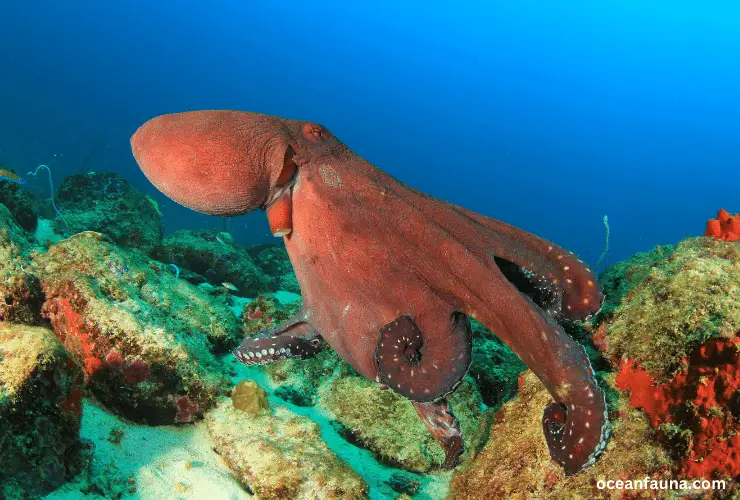
Octopuses have a round and bulbous head and body. They have a more flexible body shape that allows them to squeeze through narrow spaces and explore complex environments. They do not have any fins or internal structures except for a small beak-like mouth and a brain.
They have eight tentacles with suckers along their entire length. They have smaller eyes than squid with rectangular pupils. But they have excellent vision and can see polarized light. The octopus ranges from an inch to around 30 feet.
Did you know? Octopus has three hearts and nine brains, which make them the most intelligent creatures with problem-solving abilities.
| Feature | Squid | Octopus |
| Shape | Elongated body | Rounded body |
| Tentacles | 10 (8 arms + 2 tentacles) | 8 arms |
| Suckers | Rows of suckers on arms and tentacles | Rows of suckers on arms |
| Fins | Present | Absent |
| Shell | Internal, reduced | Absent |
| Eyes | Larger, Circular | Smaller, Triangular |
| Pen | Present | Absent |
| Size | 1 inch to 60 feet | 1 inch to 30 feet |
| Weight | Less than a gram to 1 tonne | 1 gram to 600 pounds |
4. Diet and Feeding Habits
Squids and octopuses are both carnivorous predators that feed on a variety of animals.
Squid
Squids eat fish, shrimp, and squid. They use their two long tentacles to catch prey by shooting them with a jet of water or wrapping them with their suckers or hooks. They then use their beak-like mouth to bite off chunks of flesh and swallow them whole.
Octopus
Octopuses eat crabs, lobsters, and even other octopuses. They use their eight arms to explore their surroundings and grab their prey by piercing their shells or injecting venom with their beak-like mouth. They then use their radula (a tongue-like organ with teeth) to scrape off the meat and swallow it whole.
| Characteristic | Squid | Octopus |
| Diet | Fish, shrimp, and squid | Crabs, lobsters, and other octopuses |
| Prey Capture | Shoots prey with a jet of water or wraps prey with suckers or hooks | Pierces prey’s shell or injects prey with venom |
| Prey Consumption | Bites off chunks of flesh and swallows them whole | Scrapes off meat with radula and swallows it whole |
5. Social Behavior
Both squid and octopus can change their color and pattern using special cells called chromatophores in their skin. They can use this ability for camouflage, communication, or display. They can also communicate by making noise. However, they have some differences in their social behavior.
Squid
Squids are generally more social than octopuses. Some squid species live in large groups, called shoals, while others live in smaller groups, called schools. They can also communicate using bioluminescence (light produced by their bodies).
Octopus
Octopuses are generally more solitary than squid. They typically live alone in dens or burrows. They only interact with others of their kind during mating or fighting for territory or food. They can also communicate by releasing chemicals.
| Characteristic | Squid | Octopus |
| Sociality | More social | Less social |
| Group size | Large or small groups | Solitary |
| Communication methods | Body color changes, flashing lights, noises | Body color changes, noises, chemicals |
6. Reproduction and Lifecycle
Squids and octopuses have different reproducing and developing methods.
Squid
- Mating: Squid typically mates in the fall or winter. The male squid will transfer a packet of sperm called a spermatophore to the female’s mantle cavity using a modified arm called a hectocotylus.
- Eggs: The female then lays thousands of eggs in a gelatinous mass that she attaches to rocks or seaweed.
- Larvae: The eggs hatch into tiny planktonic larvae. The larvae drift in the water column undergoing a series of molts as they develop.
- Juveniles: Once the squid larvae reach a certain size, they will settle to the bottom of the ocean. They then keep growing and eventually develop into adults.
- Adults: Squids are short-lived, usually one to five years. However, some can live up to 15 years.
Octopuses
- Mating: Octopuses typically mate in the spring or summer. The male octopus also uses a hectocotylus to transfer sperm to the female’s mantle cavity. But, rather than a spermatophore, inserts a single spermatozoon into each of the female’s oviducts.
- Eggs: The female then lays hundreds or thousands of eggs in a den or a crevice.
- Care of young: The female octopus will care for the eggs until they hatch. She will not eat during this time and eventually die after the eggs hatch.
- Juveniles: The octopus juveniles are miniature versions of the adults. They then continue growing and ultimately develop into adults.
- Adults: Octopuses typically live for one to three years. Some can live up to 5 years.
| Characteristic | Squid | Octopus |
| Mating | Fall or winter | Spring or summer |
| Eggs | Laid in a gelatinous mass | Laid in a hard, protective case |
| Care of young | No | Female guards eggs until they hatch |
| Juveniles | Planktonic | Miniature versions of the adults |
| Adults | Live for up to 15 years | Live for up to 5 years |
7. Defense Mechanism
Squids and octopuses are smart creatures. They have adopted clever ways to defend themselves from predators.
- Camouflage: They are experts at hiding. They can change their color to blend in with their environment. This makes it hard for predators to spot them.
- Ink: They have an ink sac that they use to release a dark cloud in the ocean. This ink makes it tough for predators to see them clearly. However, they also use other clever ways to defend themselves from predators. ~ (Source)
- Jet propulsion: They can also use jet propulsion to escape from predators quickly. They do this by expelling water from their siphon, which creates a force that propels them through the water.
- Autonomy: They can detach their own arms to distract predators. The arm will continue to wriggle, giving the squid time to escape.
Squid
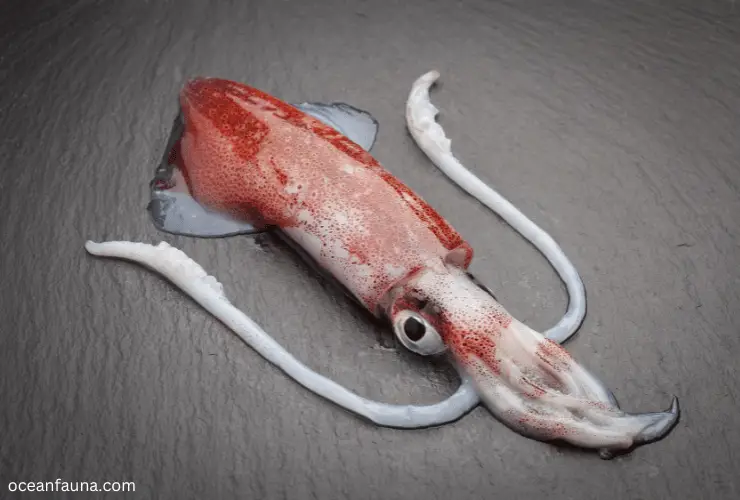
- Playing dead: Squids can sometimes play dead by lying on the bottom of the ocean and not moving. This can trick predators into thinking that the squid is not worth eating.
- Bioluminescence: They can also use bioluminescence to create a flash of light. This can startle predators and give the squid time to escape.
Octopus
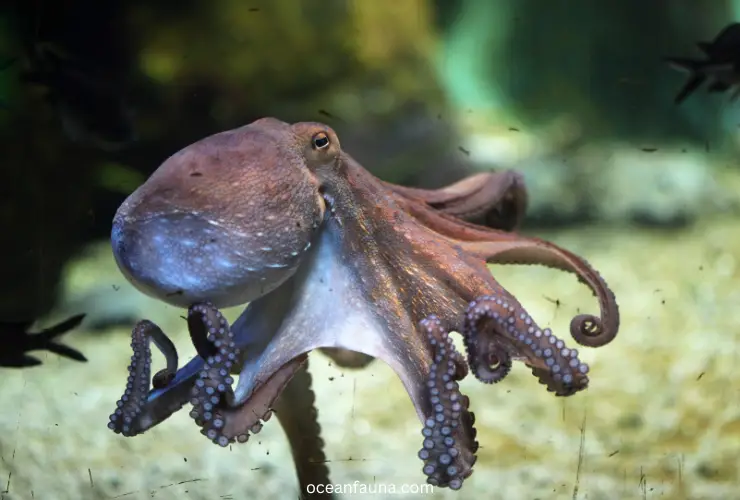
- Squeezing through tight spaces: Octopuses have a soft body and no bones. This allows them to change shape and hide in small crevices, escaping from predators.
- Strength: Octopuses are surprisingly strong for their size. They can use their arms to fight off predators.
- Intelligence: They are more intelligent than squids. They have a larger brain-to-body ratio and can solve more complex problems. They can use tools like coconut shells to protect themselves from predators.
| Defense Mechanism | Squid | Octopus |
| Camouflage | ✓ | ✓ |
| Ink | ✓ | ✓ |
| Jet Propulsion | ✓ | ✓ |
| Autonomy | ✓ | ✓ |
| Playing Dead | ✓ | ✗ |
| Bioluminescence | Some species | ✗ |
| Squeezing through tight spaces | ✗ | ✓ |
| Strength | ✗ | ✓ |
| Intelligence | ✗ | ✓ |
8. Squid Vs. Octopus: Which is Faster?
Squids and octopuses have an average speed of 35 miles per hour but differ in their swimming abilities.
Squid
Squids can achieve higher speeds, but only for shorter bursts of time. They use a combination of jet propulsion and their fins to swim. They will jet forward, then use their fins to steer and slow down.
Octopus
On the other hand, octopuses can maintain their top speed for longer durations compared to squids. They rely almost exclusively on jet propulsion. They will create a jet of water by contracting their mantle (a muscular sac surrounding their body). This jet of water propels them through the water.
Watch this video: https://www.youtube.com/watch?v=oipOtZ5ggn0
9. Interactions with Humans
Squids and octopuses have caught the eye of researchers and scientists, who are fascinated by their smarts and incredible talents. These creatures have been studied a lot for their behavior, biology, and super complex nervous systems. But each has its own unique ways of mingling with us humans.
Squid
Squids are known for their commercial value as a seafood delicacy. They are caught by fishermen for consumption and are often served in various culinary dishes worldwide, especially in Asia and Europe. Squid fishing is a popular industry, and these creatures play a significant role in the fishing economy.
Octopus
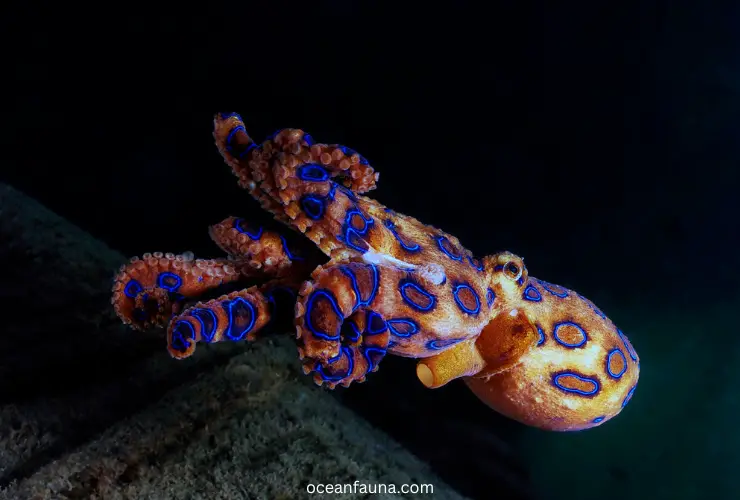
Conversely, octopuses have a whole different vibe. They are less commonly harvested for food compared to squids. Instead, octopuses are quite sneaky and avoid any interactions with us. However, lucky scuba divers and snorkelers might get a chance to see these elusive creatures in action during their underwater adventures.
10. Threats and Conservation Status
Squids and octopuses face different threats and conservation statuses.
Squid
Squids are more abundant and widespread than octopuses. Most species are not threatened by extinction. However, some squid populations are overfished or affected by climate change and pollution in some parts of the world.
Octopus
Octopuses are more vulnerable and rarer than squid. Some species are endangered and threatened. The main threats to octopuses are habitat loss, overfishing, bycatch, and illegal trade.
Are Squid and Octopus Related?
Squid and octopus are related, but not very closely. They belong to the same class of animals called Cephalopoda.
Cephalopods are mollusks, which means they have soft bodies without bones. They also have
- A beak-like mouth
- A radula (a tongue-like organ with teeth)
- A siphon (a tube-like organ for jet propulsion
- A mantle (a muscular sac that covers the body).
However, squid and octopus belong to different orders within the class Cephalopoda.
Squid belongs to the order Teuthida, which includes about 300 squid species. In contrast, octopuses belong to the order Octopoda, with 300 species of octopus.
FAQS
Who Hunt Squid and Octopus?
A: Squid and octopus are hunted by a variety of animals, including
- Sharks
- Dolphins
- Whales
- Sea turtles
- Sea lions
- Seals
- Seabirds
- Humans
Squids and octopuses are also cannibalistic and will sometimes eat each other.
What is the difference between squid calamari and octopus?
A: Squid calamari is the culinary name for squid meat that is usually fried or grilled. Octopus is the common name for the animal and its meat that is generally boiled or braised. Squid calamari has a mild flavor and chewy texture, while octopus has a stronger and tougher flavor.
Is a squid a baby octopus?
A: No, a squid is not a baby octopus.
Are squid and octopus the same to eat?
A: Squids and octopuses are two different types of sea creatures commonly eaten worldwide. Although they might appear alike and share a few similarities, they actually have distinct tastes and textures.
Squids have a firmer texture. In contrast, octopuses are softer and offer a unique flavor experience. So, if you’re in the mood for a seafood adventure, try both squids and octopuses to see which suits your taste buds better.
Is squid meat or fish?
A: Squid is a part of the mollusk family, along with clams, oysters, and octopuses. Unlike fish, squids do not have scales, which means they are not technically considered fish.
However, despite this distinction, squids have a delicious taste and texture resembling other seafood types. Because of this, squids are often included in the seafood category. So, its classification as meat or fish depends on how it is cooked and prepared.
Conclusion
So, how can you tell them apart when you are exploring the deep blue? Look for the signs! Squids have elongated bodies, two fins on the sides of their heads, and tentacles equipped with suction cups. Meanwhile, octopuses have rounded bodies, no fins, and eight arms lined with suckers.
It is like a thrilling game of spot-the-difference, observing the unique traits of these fascinating sea creatures. We hope you have enjoyed discovering these amazing differences between squids and octopuses!

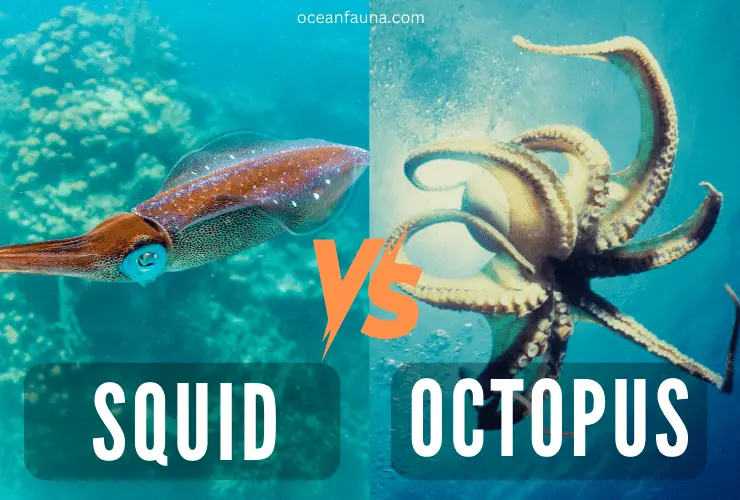
1 thought on “Squid Vs Octopus: What are the Key Differences?”